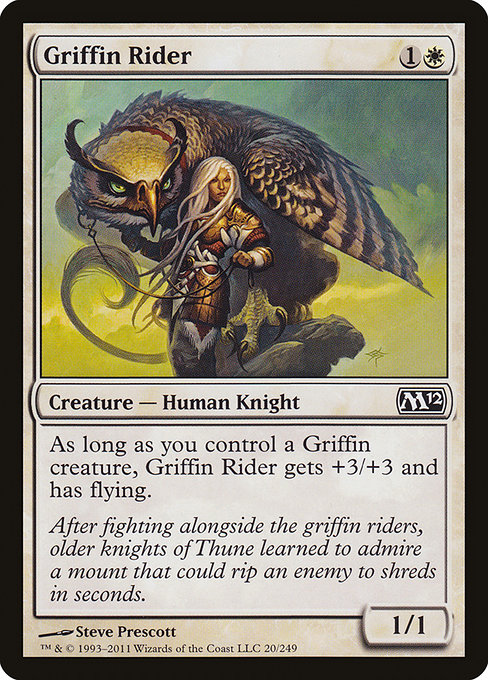
Image courtesy of Scryfall.com
Griffin Rider: A Case Study in Subtle Card Design
In the vast sea of white commons, Griffin Rider stands as a deceptively simple banner of efficiency and texture. A modest 2-mana cost for a 1/1 Human Knight, its true value blooms once you start pairing it with a silver-winged ally in play. The ability—“As long as you control a Griffin creature, this creature gets +3/+3 and has flying.”—reads like a quiet whisper that becomes a roar when your skies fill with griffins 🧙🔥💎. This is not just a power boost; it’s a design philosophy: let a card pair with a specific other card or creature type to unlock a dynamic, memorable board state.
Griffin Rider hails from Magic 2012 (M12), a core-set era known for teaching fundamentals with clarity. Its white color identity, common rarity, and direct Power/Toughness line make it approachable for new players while still offering a satisfying payoff for veterans who enjoy tribal or synergy-focused play. The card’s flavor text—“After fighting alongside the griffin riders, older knights of Thune learned to admire a mount that could rip an enemy to shreds in seconds.”—grounds the mechanic in a lore moment that fans can latch onto when building custom cards or fan lore. This blend of function and flavor is precisely what animates fan-driven design across communities 🎨⚔️.
Mechanics that Age Well
There are a few design lessons hidden in this small spell snippet that echo through countless fan-made cards:
- Conditional power boosts beat blanket effects for beginners, because they require you to actively assemble a board state. Griffin Rider rewards planning and timing rather than simply throwing raw stats on the board 🧙🔥.
- Tribal identity without over-commitment—the card leans into Griffin synergy without requiring an entire Griffin-centric deck to function. This keeps fan cards versatile enough for varied playgroups.
- Low mana cost, high ceiling is a classic recipe for memorable plays. A 2-mana creature becoming a 4/4 flier with a griffin on the battlefield creates chunky turns that players remember long after the game ends 🔥.
- Text readability matters. The ability is compact and easy to parse, which makes it a prime template for fan designers seeking to craft clean, teachable effects.
For fan creators, Griffin Rider demonstrates that you don’t need flashy keywords or overbearing text to leave an impact. A simple conditional buff, paired with a creature type and a flavorful theme, can spark countless deck-building ideas and even foster new communities around a shared mechanic. It’s a blueprint for accessible design that still carries weight on a real board 🎲.
Flavor, Lore, and Worldbuilding as Design Fuel
“After fighting alongside the griffin riders, older knights of Thune learned to admire a mount that could rip an enemy to shreds in seconds.”
That flavor text isn’t just ornament; it hints at a broader world where mounts and rider orders shape battlefield tempo. Fan designers often mine this kind of lore to justify mechanical choices. If your custom card features a creature that grows stronger with a specific ally or environment, you can weave a story about rival factions, ancient alliances, or legendary mounts. Griffin Rider shows how a tiny narrative hook can justify a potent mechanical payoff, turning a casual upgrade into a meaningful swing in combat. The result is cards that feel as if they belong to a lived-in fantasy world, not just a spreadsheet of numbers 🧙🔥🎨.
Visual Design and Collectability
On the page and on the table, Griffin Rider’s design speaks to the balance between art and utility. The M12 frame—classic black border, clean typography, and a straightforward creature type line—helps new players quickly identify what the card does and when it will matter. The fact that this card is common also speaks to its role as a teaching tool; it demonstrates that valuable decisions don’t require rare status. Collectors often enjoy the contrast between common cards with surprising power and their foil or nonfoil variations, which is echoed in Griffin Rider’s foil availability and price points across markets. Even as a low-cost, common creature, the card carries a sense of potential that players love to chase in casual play and fan-driven tournaments alike 💎⚔️.
Fan Card Design Takeaways
- Use conditional effects to invite strategic timing rather than brute force on every turn.
- Anchor the mechanic with a clear creature type or theme so fan cards feel cohesive within a broader world.
- Pair concise text with flavorful flavor text to deepen engagement without bogging down gameplay.
- Consider connectivity to widely recognized archetypes (like griffin creatures) to maximize cross-compatibility in fan-made sets.
For fans who love bridging the gap between tabletop play and real-world hobbies, such synergy invites cross-pollination—between deck-building, lore exploration, and even collecting. It’s the kind of design philosophy that fuels the best fan sets: cards that feel like they could belong to a coordinated storyline, while still being approachable enough for kitchen-table magic ☕🧙♂️.
As you explore design ideas, you might also be drawn to real-world gear that carries the same spirit of clever utility—like the compact, stylish storage solutions that keep your card collection safe on the go. If you’re hunting for a convenient, well-made accessory to accompany your gaming sessions or display your favorite cards, consider this practical traveler’s companion: a phone case with a built-in card holder and MagSafe compatibility. It’s a tiny nod to MTG’s blend of form and function, pairing everyday practicality with a touch of collector’s flair. Ready to upgrade your travel setup? 🧙🔥💎